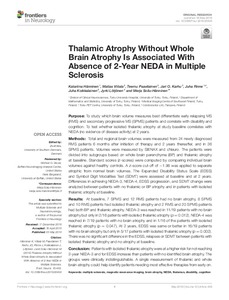| dc.contributor.author | Hänninen K | |
| dc.contributor.author | Koikkalainen J | |
| dc.contributor.author | Karhu JO | |
| dc.contributor.author | Rinne J | |
| dc.contributor.author | Soilu-Hänninen M | |
| dc.contributor.author | Lötjönen J | |
| dc.contributor.author | Viitala M | |
| dc.contributor.author | Paavilainen T | |
| dc.date.accessioned | 2022-10-28T12:34:39Z | |
| dc.date.available | 2022-10-28T12:34:39Z | |
| dc.identifier.uri | https://www.utupub.fi/handle/10024/160538 | |
| dc.description.abstract | Purpose: To study which brain volume measures best differentiate early relapsing MS (RMS) and secondary progressive MS (SPMS) patients and correlate with disability and cognition. To test whether isolated thalamic atrophy at study baseline correlates with NEDA (no evidence of disease activity) at 2 years.Methods: Total and regional brain volumes were measured from 24 newly diagnosed RMS patients 6 months after initiation of therapy and 2 years thereafter, and in 36 SPMS patients. Volumes were measured by SIENAX and cNeuro. The patients were divided into subgroups based on whole brain parenchyma (BP) and thalamic atrophy at baseline. Standard scores (z-scores) were computed by comparing individual brain volumes against healthy controls. A z-score cut-off of - 1.96 was applied to separate atrophic from normal brain volumes. The Expanded Disability Status Scale (EDSS) and Symbol Digit Modalities Test (SDMT) were assessed at baseline and at 2 years. Differences in achieving NEDA-3, NEDA-4, EDSS progression, and SDMT change were analyzed between patients with no thalamic or BP atrophy and in patients with isolated thalamic atrophy at baseline.Results: At baseline, 7 SPMS and 12 RMS patients had no brain atrophy, 8 SPMS and 10 RMS patients had isolated thalamic atrophy and 2 RMS and 20 SPMS patients had both BP and thalamic atrophy. NEDA-3 was reached in 11/19 patients with no brain atrophy but only in 2/16 patients with isolated thalamic atrophy (p = 0.012). NEDA-4 was reached in 7/19 patients with no brain atrophy and in 1/16 of the patients with isolated thalamic atrophy (p = 0.047). At 2 years, EDSS was same or better in 16/19 patients with no brain atrophy but only in 5/17 patients with isolated thalamic atrophy (p = 0.002). There was no significant difference in the EDSS, relapses or SDMT between patients with isolated thalamic atrophy and no atrophy at baseline.Conclusion: Patients with isolated thalamic atrophy were at a higher risk for not reaching 2-year NEDA-3 and for EDSS increase than patients with no identified brain atrophy. The groups were clinically indistinguishable. A single measurement of thalamic and whole brain atrophy could help identify patients needing most effective therapies from early on. | |
| dc.language.iso | en | |
| dc.publisher | FRONTIERS MEDIA SA | |
| dc.title | Thalamic Atrophy Without Whole Brain Atrophy Is Associated With Absence of 2-Year NEDA in Multiple Sclerosis | |
| dc.identifier.url | https://www.frontiersin.org/articles/10.3389/fneur.2019.00459/full | |
| dc.identifier.urn | URN:NBN:fi-fe2021042825271 | |
| dc.relation.volume | 10 | |
| dc.contributor.organization | fi=kliiniset neurotieteet|en=Clinical Neurosciences| | |
| dc.contributor.organization | fi=Matematiikan ja tilastotieteen laitos|en=Department of Mathematics and Statistics| | |
| dc.contributor.organization | fi=kliinisen laitoksen yhteiset|en=Department of Clinical Medicine| | |
| dc.contributor.organization | fi=tyks, vsshp|en=tyks, vsshp| | |
| dc.contributor.organization | fi=diagnostinen radiologia|en=Diagnostic Radiology| | |
| dc.contributor.organization | fi=PET perustoiminta|en=PET Basic Operations| | |
| dc.contributor.organization-code | 2607314 | |
| dc.contributor.organization-code | 2609810 | |
| dc.contributor.organization-code | 2607300 | |
| dc.contributor.organization-code | 2607303 | |
| dc.converis.publication-id | 40675388 | |
| dc.converis.url | https://research.utu.fi/converis/portal/Publication/40675388 | |
| dc.identifier.eissn | 1664-2295 | |
| dc.identifier.jour-issn | 1664-2295 | |
| dc.okm.affiliatedauthor | Rinne, Juha | |
| dc.okm.affiliatedauthor | Kuutti, Katariina | |
| dc.okm.affiliatedauthor | Dataimport, Matematiikan ja tilastotieteen laitos | |
| dc.okm.affiliatedauthor | Paavilainen, Teemu | |
| dc.okm.affiliatedauthor | Dataimport, tyks, vsshp | |
| dc.okm.affiliatedauthor | Soilu-Hänninen, Merja | |
| dc.okm.discipline | 3124 Neurology and psychiatry | en_GB |
| dc.okm.discipline | 3124 Neurologia ja psykiatria | fi_FI |
| dc.okm.internationalcopublication | not an international co-publication | |
| dc.okm.internationality | International publication | |
| dc.okm.type | Journal article | |
| dc.publisher.country | Sveitsi | fi_FI |
| dc.publisher.country | Switzerland | en_GB |
| dc.publisher.country-code | CH | |
| dc.relation.articlenumber | ARTN 459 | |
| dc.relation.doi | 10.3389/fneur.2019.00459 | |
| dc.relation.ispartofjournal | Frontiers in Neurology | |
| dc.year.issued | 2019 | |
